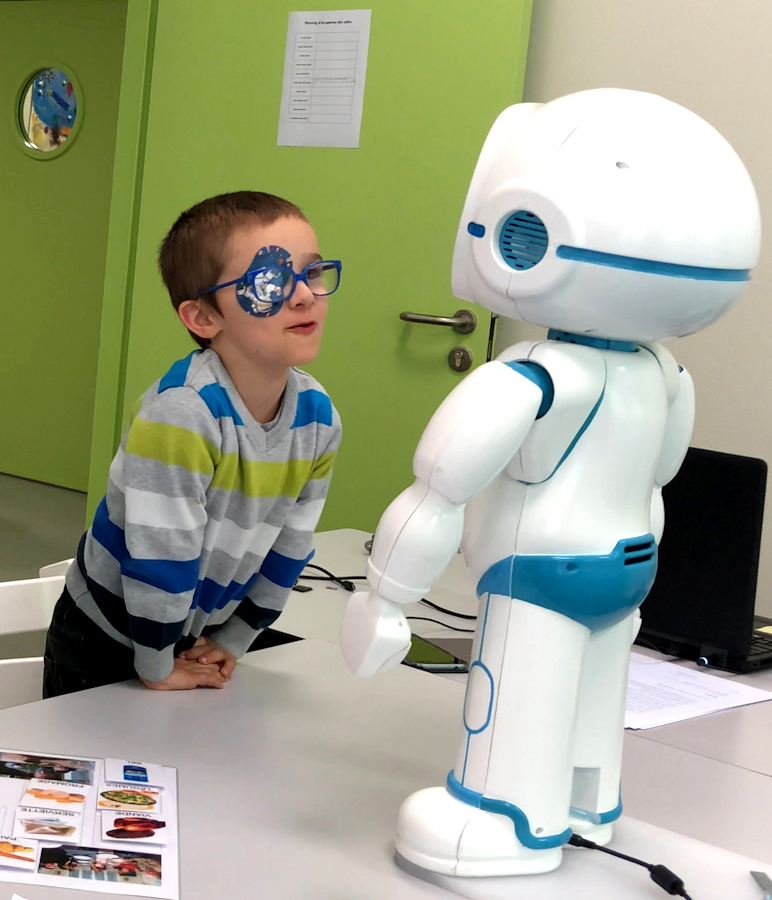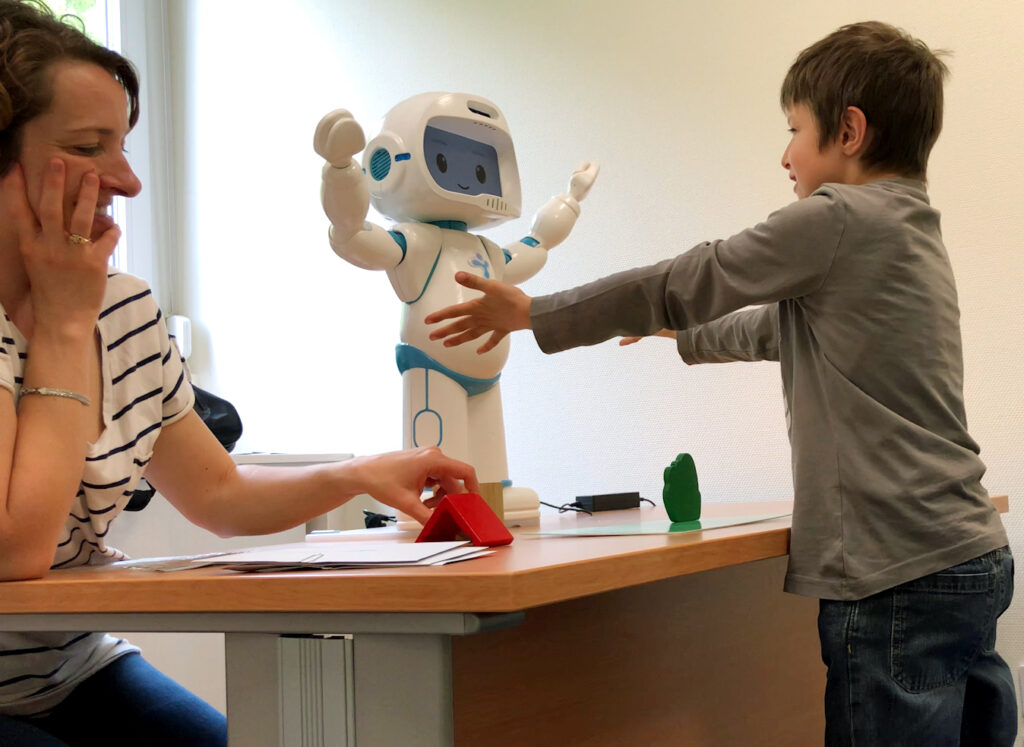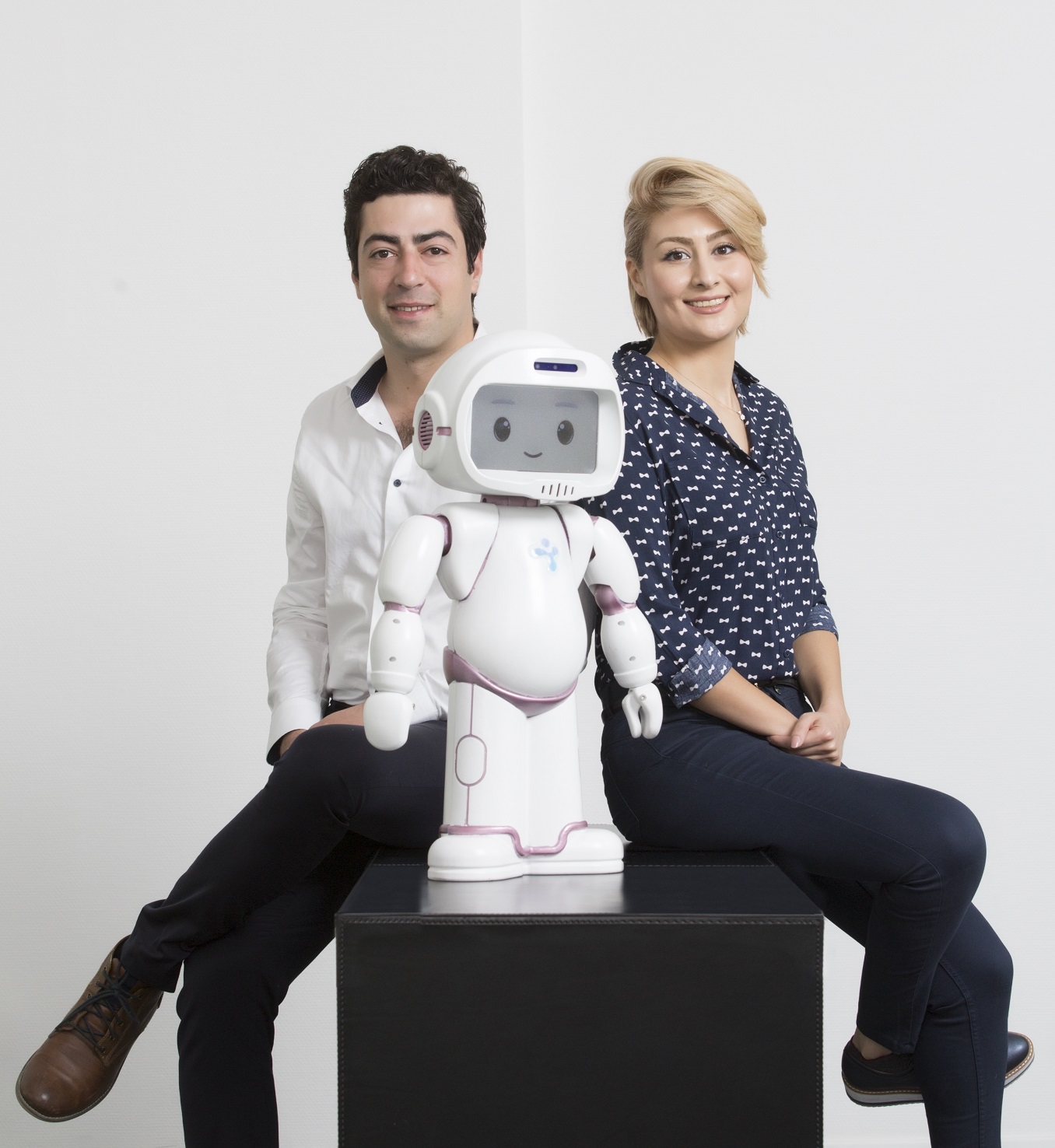BACK TO RESEARCH WITH IMPACT: FNR HIGHLIGHTS
BACK TO RESEARCH WITH IMPACT: FNR HIGHLIGHTS
Luxembourg start-up LuxAI, with their socially assistive robot QTrobot, has been making waves on an international level since it was created. The FNR has supported the project from its inception through the development of a prototype, helping bridge the gap between lab and commercialisation. We speak to LuxAI founders Dr Pouyan Ziafati and Dr Aida Nazarikhorram about the LuxAI journey so far; how QTrobot came to be and how parents can now have a QTrobot at home.

The World Health Organisation (WHO) estimates around 1 in 59 children worldwide have an Autism Spectrum Disorder (ASD). Children with autism have trouble communicating, as well as trouble understanding what other people think and feel. This makes it is hard for them to express themselves with e.g. words, gestures, facial expressions, and touch.
“Each child with autism is unique. They have their own strengths and their own needs”, says Dr Aida Nazarikhorram, CCO of LuxAI. LuxAI is a spin-off company that has come out of the University of Luxembourg and offers an innovative approach to therapy for children with autism: QTrobot, a little, visually appealing, talking robot. The 60cm humanoid robot is designed to aid autism professionals in helping children with autism to learn new social, emotional and communication skills.
The robot tells stories, plays games and makes dialogue, through which it teaches necessary skills to children with special educational needs. For instance, using its expressive face and body movement, QT teaches children what emotions are and how to deal with them. There is also a version of the QT robot for researchers.



Born out of interdisciplinarity
Rewind to 2011 – Pouyan Ziafati starts his AFR PhD jointly at the University of Luxembourg and University of Utrecht. The title of the PhD project was ‘Programming Cognitive Robotics’, suggesting that LuxAI CEO Dr Pouyan Ziafati, who completed his PhD in 2015, knew in which direction he wanted his research to go since day one.
Fittingly for Luxembourg, where an interdisciplinary approach to science is a matter of course, it was partly thanks to the different backgrounds of Dr Pouyan Ziafati – a computer scientist specialised in AI – and his wife Dr Aida Nazarikhorram – a medical doctor – that the idea of creating the robot QT came to be.
“There are many areas in healthcare in which using AI and Robotics can be a game changer”
“Being a couple with two different backgrounds, one in AI and robotics and one in medicine, it was always interesting for us to learn more about each other’s domains. The discussions opened the door to find out that there are many areas in healthcare in which using AI and Robotics can be a game changer.” Aida says.
“At first, it was just an interesting topic of discussion, but gradually it became clear that developing an interdisciplinary venture would be very appealing for both of us. After doing early market research for a variety of health-related AI applications, we came up with the idea of a robot so easy to use that it can be used by every healthcare professional, starting from the domain of autism, which was the one most in need for an urgent solution,” Pouyan adds.
Developing with the user
In 2015, the University of Luxembourg (SnT) team around QTrobot successfully applied for a grant from the FNR’s Proof of Concept programme (now called JUMP) and by the end of that year, the prototype of QTrobot was ready. Pouyan and Aida explain that a rule they had set from the beginning was to ‘develop with the user’. Thus, the prototype was immediately put in use in pilot project in autism centers, as well as autism research projects in Luxembourg.
Researchers at the University who used the robot with children, such as Dr Andreia Pinto Costa, observed that children with autism look at the robot longer than they look at a person, suggesting the children are more comfortable with the interaction with the robot than with a person.
The researchers explain that children with autism often suffer because they do not get specialised interventions – a missing element the robot can fill. The robot is not intended to replace therapy, but to improve and customise it.
Fewer disruptive behaviours, better concentration
Educators at a therapy centre for children with autism in France, who worked with the prototype, have seen a direct impact on the children’s learning abilities, which also indirectly leads to better relationships with their parents. The children show fewer disruptive behaviours, and are able to maintain concentration for much longer periods – they need fewer breaks and find it easier to focus.
The educators also realised they could extend the use of the robot to educate children with any disability. They easily managed to integrate QTrobot into their daily routines, such as speech, behavioural and occupational therapies – the traditional treatments they use on a daily basis can simply be adapted to QTrobot. Key is also the intuitive programming of the robots, one of the educators explains that once you know the basics, it more or less programmes itself.

LuxAI: A fast rise, much more to come
After some time working with the QTrobot prototype, researchers and educators, Pouyan Ziafati and Aida Nazarikhorram launched their company LuxAI S.A. in May 2016 – and immediately got attention: Within months of launching their company, they won awards such as the first prize at Mind&Market, the best healthcare facility award. Then came more than 10 international prestigious awards, including the top 10 best ideas from Europe by EU commission, one of the Best social innovations by European investment bank and winning the award of the Tech for a better world from CES 2019. Pouyan Ziafati also won an FNR Award for Outstanding Research-Driven Innovation in 2017.

“The most important achievement is that now we are shipping our robots globally, from US to China, and every day QTrobot is working hand in hand with autism therapists and human robot interaction researchers to create a better world,” Pouyan and Aida explain.
Pouyan explains that LuxAI imagines QTrobot as the first in a row of products: “For us, QTrobot is an introduction to the market. There is great potential in using AI in healthcare that allows us to see a variety of products, both hardware and software that can be added to our portfolio.”
QTrobot now available to have at home
After several years of experience in offering QTrobot to schools and research institutes, LuxAI now aims to support parents by offering their robot to families: In April 2021, LuxAI announced QTrobot for Home enables children to receive a learning experience that, quite literally, speaks directly to them – at home.
“We are launching the parent version of QTrobot after a highly successful pilot with our beta testers. We are delighted to see we can help parents to continue their children’s education during the covid-19 closure of schools.
LuxAI has developed a full ecosystem to assist parents in actively participating in their child’s education with QTrobot and to further conduct supporting activities to encourage the application of the skills learnt from the robot to new environments.
Following our successful work in research and education, we have gone to great lengths to minimize costs and make this advanced robot as affordable as possible.”
“Proof of Concept [JUMP] is an incredibly valuable programme, targeting the most important barrier in transforming academic results to commercially viable solutions”
Pouyan has benefitted from the FNR’s funding programmes since he began his research career in Luxembourg. His PhD was funded by the FNR’s AFR programme. “The AFR project is a great scheme, allowing innovative young researchers to develop their own research project and allowing universities to attract new researchers who are not necessarily the best fit for the existing projects, but can initiate new possibilities and new spectrum.”
Soon after the completion of his PhD, it was a grant from the FNR’s Proof of Concept (JUMP) programme that enabled the creation of the QTrobot softwre prototype. The JUMP programme helps scientists bridge the technical and funding gap between research-driven discoveries and their commercialisation, thereby enhancing the impact of Luxembourg’s research on economy and society.
“Proof of Concept [JUMP] is an incredibly valuable programme, targeting the most important barrier in transforming academic results to commercially viable solutions. It enables access to the hard to obtain financing for early stage research-driven innovations to advance them in stages suitable for funding from customers and private investors. It also provides a great support in terms of transforming as a researcher to an entrepreneur with a commercial and business mindset,” Pouyan explains, adding:
“As a researcher with an idea, the chance of finding a source of private funding is not so high, since you don’t have any evidence of market and even you don’t have any evidence that your idea is even feasible. Proof of Concept [JUMP] allows you to transform your idea to a minimum viable solution and demonstrate that your product has great business potential. So now you are ready to be on your own and explore many other opportunities.”
More information
FNR JUMP programme
Photos copyright: LuxAI S.A.
Related
More innovation highlights

RELATED PROGRAMMES